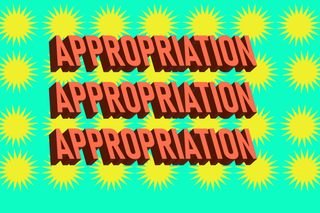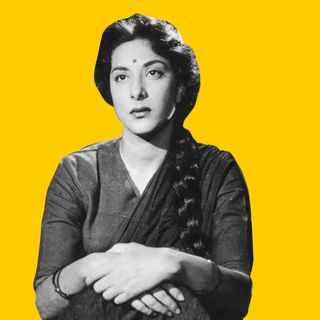
Words Mean Things: ‘Appropriation’
The conversation about appropriation has been confined to individual white celebrities — but this ignores the workings of power closer home.

In Words Mean Things, we unpack weighty words whose meanings have been sacrificed to hot takes.
This week, the word appropriation re-entered the Twittersphere — if it had ever really left, that is. American singer Gwen Stefani was accused of cultural appropriation (again) when she claimed she felt connected to Japanese culture. Stefani has been consistent in her use of fashion and artistic references from other cultures — but there’s something about the debate this time that caused renewed confusion about what appropriation even means anymore, and why celebrities are overwhelmingly the center of conversations about it. As one Al Jazeera article noted, the Gwen Stefani appropriation debate was mostly confined to predominantly Western spaces. Here is a story in two tweets, summarizing the backlash:
Tweet one: “I’m here for the Asian community blamingGwen Stefani for her years of racism, cultural theft, and Orientalism. Now, keep that same energy and call out K-pop and the cultural appropriation by Asian musicians who profit from Black culture while being anti-Black.”
Tweet two: “Conversations about K-Pop and ‘appropriation’ are really grating to me [because] it once again makes everything about our wildly global world U.S.-centric, and that’s just intellectually lazy.”
It raises interesting questions about what we’ve considered appropriation to even mean — what qualifies? Even forgetting Gwen Stefani for a moment, “appropriation” has had a confused, nebulous meaning for a while. It’s been used to call out people for trying different cuisines, and even to debate whether the use of “Howdy” by non-Texans is okay.
After a point, then, it all feels, to use another recent Twitter neologism, deeply unserious.
The standard definition of the word goes something like this: “Taking intellectual property, traditional knowledge, cultural expressions, or artifacts from someone else’s culture without permission. This can include unauthorized use of another culture’s dance, dress, music, language, folklore, cuisine, traditional medicine, religious symbols, etc.,” according to Susan Scafidi, author of Who Owns Culture? Appropriation and Authenticity in American Law. “It’s most likely to be harmful when the source community is a minority group that has been oppressed or exploited in other ways or when the object of appropriation is particularly sensitive, e.g. sacred objects.”
Even scholars admit, however — it’s simultaneously not easy to define and, thereby therefore, too easy to use in common parlance. “During the last ten years, the term appropriation has become ubiquitous in the discourse of many disciplines, but–despite its manifest usefulness in academic argument–it remains conceptually unstable,” notes one paper. The term is most potently used to describe the processes of colonization — and decolonization, subsequently.
A lesser-known meaning of the term is its application in describing colonized cultures using the language, tools, and ideas of the colonizers to subvert the powers that be. “Shakespeare has been and is appropriated by those who would explore, affirm and resist empire,” noted one article.
Related on The Swaddle:
India Has Often Appropriated, Seldom Appreciated, Its Courtesan Culture
But the debates around appropriation tend to revolve around isolated celebrity moments — specifically, White celebrities. This frames the issue as something that White people are predominantly guilty of — ignoring the colonial power structures that the word was supposed to represent.
“The definition of appropriation originates in its inversion, cultural autonomy. Cultural autonomy signifies a right to cultural specificity, a right to one’s origins and histories as told from within the culture and not as mediated from without… the basis of cultural autonomy is contained within the concept of Aboriginal Title and Rights,” wrote De Loretta Todd.
In the Indian context, the appropriation conversation has correspondingly remained confined to the diaspora in the West. But this ignores one of the most pervasive and oldest forms of appropriation — one that is caste-based. Take the art form of Bharatnatyam. “Several dance forms in South India — primarily Bharatanatyam, Kuchipudi, Mohiniyattam, and Vilasininatyam — were appropriated from Bahujan communities,” the dancer Nrithya Pillai told The Swaddle in 2021. “When Rukmini Devi created the reformed version of Bharatanatyam, it was appropriated by upper-caste women. But now these women say they don’t want the reformed version — they want the older dance. So now they are portraying what they claim is the older form of the dance and appropriating that as well.”
Similarly, heavily stigmatized courtesans were shunned from society despite pioneering several classical art forms — these have now been appropriated into the mainstream, their histories long forgotten. In other words, appropriation involves a historical relationship of power between communities — making the act of owning, representing, or claiming another culture an act of continued or prolonged colonial violence.
And yet, the conversation around cultural appropriation as it pertains to Indians remains overwhelmingly ahistorical. It’s usually confined to discussions of South Asians imitating Black culture. Many have argued that it is appropriation — but on the flip side, it could just be cringe, problematic, and even borderline racist when the N-word is involved. Similarly, Rihanna was called out for culturally appropriating Hindu culture when donning a Ganesha necklace, topless.
Ignoring the history of two cultures when we call out appropriation, then, leads to greater erasure. The conversation centering on individual celebrities or individual people with privilege, overshadows the real and ongoing one-directional osmosis of several forms of art that are taking place in real-time, today.
That’s perhaps why, when it comes to appropriation, we’re left with takes like this: “One of the last frontiers of cultural appropriation we haven’t crossed yet is a [F]rench person pretending to be [F]rench [C]anadian.”
Rohitha Naraharisetty is a Senior Associate Editor at The Swaddle. She writes about the intersection of gender, caste, social movements, and pop culture. She can be found on Instagram at @rohitha_97 or on Twitter at @romimacaronii.
Related


Is This Normal: ‘I Can’t Stand Different Foods Touching Each Other on My Plate’
